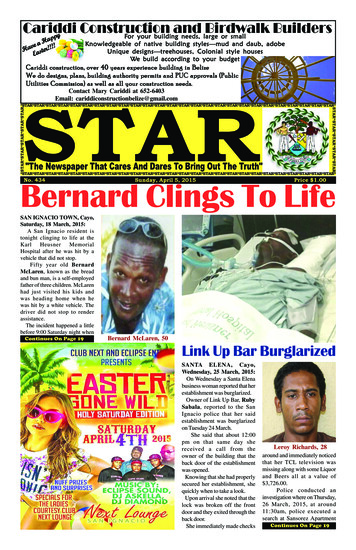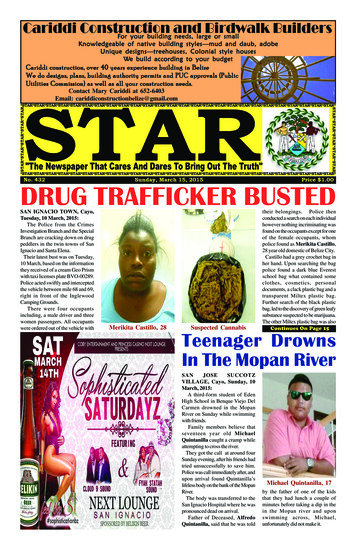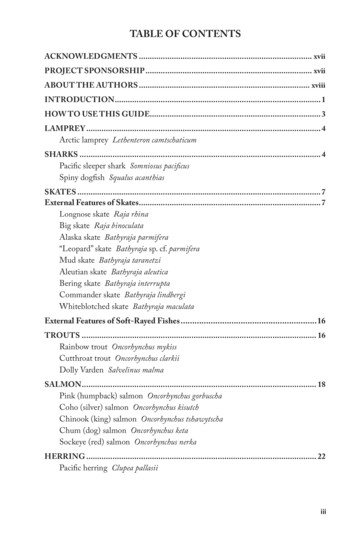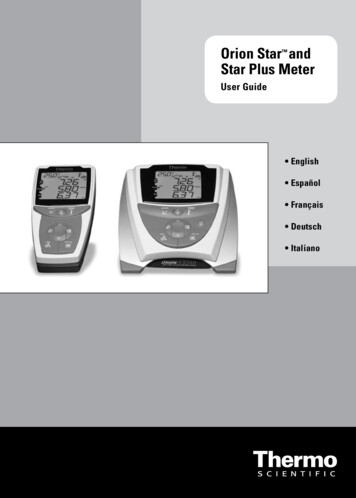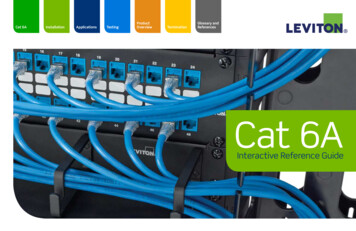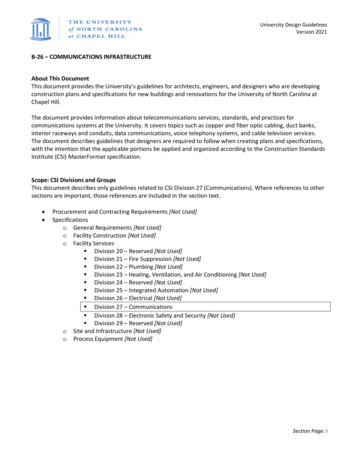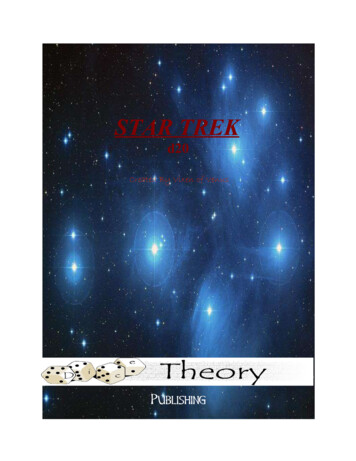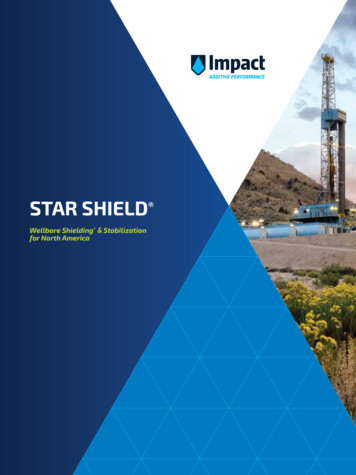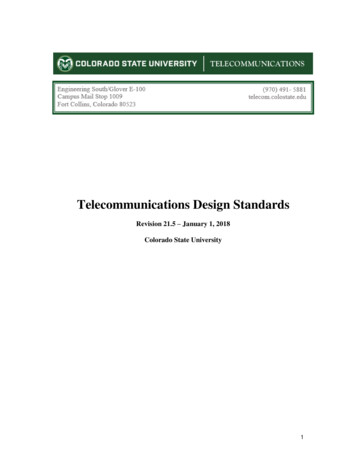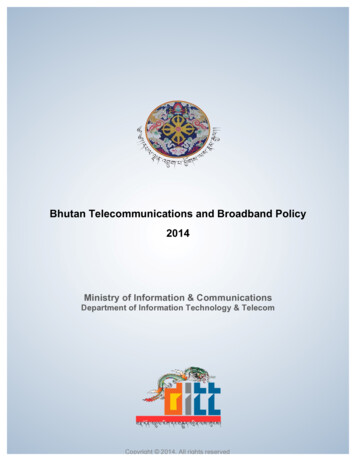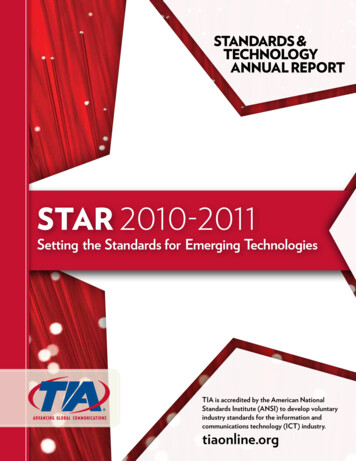
Transcription
Standards &TechnologyAnnual reportSTAR 2010-2011Setting the Standards for Emerging TechnologiesTIA is accredited by the American NationalStandards Institute (ANSI) to develop voluntaryindustry standards for the information andcommunications technology (ICT) industry.tiaonline.org
TIA STAFFEX ECUTIV EGrant SeiffertPresident 1.703.907.7701gseiffert@tiaonline.orgAndrew KurtzmanVice President and CorporateCounsel 1.703.907.7413akurtzman@tiaonline.orgMary Piper WatersSenior Director of Operations RST ECHNOLOGYAnd STANDARDSCheryl BlumVice President, Technology andBusiness Development 1.703.907.7436cblum@tiaonline.orgJohn DerrDirector, Technical Programs 1.703.907.7791jderr@tiaonline.orgGeorge IvanovManager, Technology andStandards 1.703.907.7702givanov@tiaonline.orgTeesha JenkinsDanielle CoffeyCommittee Management SpecialistVice President, Government Affairs 1.703.907.7706 ine.orgMatt LanghanJoseph AndersenAdvisor, Energy, Environment and Manager, Standards InternetDevelopmentInnovation, Government Affairs 1.703.907.7482 nline.orgNick FetchkoDirector, International andGovernment Affairs 1.202.346.3246nfetchko@tiaonline.orgCarolyn Holmes LeeDirector, Legislative andGovernment Affairs 1.202.346.3245clee@tiaonline.orgAnne PizzatoManager, International andGovernment Affairs 1.202.346.3247apizzato@tiaonline.orgBrian ScarpelliManager, Government Affairs 1.202.346.3251bscarpelli@tiaonline.orgTamara WilliamsStaff Assistant 1.202.346.3240twilliams@tiaonline.orgAbout TIAen vi ro n m en t,n et wo rki n gandi n t elli g en c eTaly WalshVice President, Sustainability,Intelligence and Networking 1.703.907.7744twalsh@tiaonline.orgJeff HannahEvent Marketing Manager 1.703.907.7582jhannah@tiaonline.orgLois ParksManager, Member Relations 1.703.907.7739lparks@tiaonline.orgMike SnyderPR Director 1.703.907.7723msnyder@tiaonline.orgOPERAT ION SBisrat BainesagnSenior Network Manager 1.703.907.7718bbainesagn@tiaonline.orgMichelle MelsopEvents Coordinator 1.703.907.7002mmelsop@tiaonline.orgLida BerlejungController 1.703.907.7720lberlejung@tiaonline.orgFlorence SumarayDirector, Marketing 1.703.907.7471fsumaray@tiaonline.orgLisa MaghraouiDirector, Human Resources 1.703.907.7716lmaghraoui@tiaonline.orgMARKE T ING,ME MB ERS H IPA n d B U S INES SDE V ELOP MENTTuan NguyenSenior Web Developer 1.703.907.7738tnguyen@tiaonline.orgRonda MarrowCommittee Management SpecialistJohn Jacobs 1.703.907.7974Vice President, Membership,rmarrow@tiaonline.orgMarketing and BusinessVictoria MitchellDevelopmentDirector, Technology and 1.703.907.7747Standardsjjacobs@tiaonline.org 1.703.907.7779Ancilla Bradyvmitchell@tiaonline.orgDirector, Member Relations andStephanie MontgomeryServicesSenior Director, Technology and 1.703.907.7713Business Developmentabrady@tiaonline.org 1.703.907.7735Eileen Bramletsmontgomery@tiaonline.orgSenior Director of MarketingFlorence Otieno 1.703.907.7749Senior Manager, Internationalebramlet@tiaonline.orgStandards ProgramsBruce Degn 1.703.907.7556Director, Member Developmentfotieno@tiaonline.organd SalesJeffrey West 1.703.907.7000Senior Network Manager 3GPP2bdegn@tiaonline.org 1.703.907.7730jwest@tiaonline.orgMary Piper WatersSenior Director of Operations 1.703.907.7701mwaters@tiaonline.orgTony ZarafsharSr. Manager, Information andTechnology Services 1.703.907.7775tzarafshar@tiaonline.orgtia n owAbe NejadICT Journalist/Anchor 1.703.907.7004anejad@tiaonline.orgDave PeisachDirector, Digital Media Services 1.703.907.7003dpeisach@tiaonline.orgBrian WestDirector, Interactive Media 1.703.907.7493bwest@tiaonline.orgThe Telecommunications Industry Association (TIA) represents the global information and communications technology (ICT) industry throughstandards development, advocacy, tradeshows, business opportunities, market intelligence and worldwide environmental regulatory analysis.Since 1924, TIA has been enhancing the business environment for broadband, mobile wireless, information technology, networks, cable,satellite and unified communications. Members’ products and services empower communications in every industry and market, includinghealthcare, education, security, public safety, transportation, government, the military, the environment and entertainment.
Table of ContentsM essage s from the TIA Le a ders h i pLetter from the Chairman of the Board and TIA's President. 3Letter from the Technical Committee Chairman.5Rec ent sta nda rds activiti esTIA, Georgia Institute of Technology Sign MOUto Develop Standardization Collaboration. 6Global Standards Collaboration Machine-to-Machine Standardization Task Force. 7Engineering Committee R ep o rtsTR-8 Mobile and Personal Private Radio Standards. 8TR-14 Point-to-Point Communications Systems.12TR-30 Multi-Media Access, Protocols and Interfaces.14TR-34 Satellite Equipment and Systems.16TR-41 User Premises Telecommunications Requirements.18TR-42 Telecommunications Cabling Systems. 22TR-45 Mobile and Personal Communications Systems. 26TR-47 Terrestrial and Non-Terrestrial Mobile Multimedia Multicast (TM3). 34TR-48 Vehicular Telematics. 36TR-49 Healthcare ICT. 39NEW TR-50 Smart Device Communications.41NEW TR-51 Smart Utility Networks. 43TI A Globa l Involve me ntMap of The Worldwide Reach of TIA Standards.30–31ISO/IEC JTC 1/SC 25 Interconnection of Information Technology Equipment. 45IEC TC 46 Cables, Wires, Waveguides, R.F. Connectors,R.F. and Microwave Passive Components and Accessories. 47IEC TC 76 Optical Radiation Safety and Laser Equipment. 50IEC TC 86 Fibre Optics.53ISO TC 204 Intelligent Transport Systems. 563GPP2 Third Generation Partnership Project 2. 58TIA Standards Development Program Participants.60TI A BOARD MEMB ERSACS*AdtranAlcatel-LucentANDA NetworksCisco SystemsCorning Incorporated*Ericsson, Inc.FAL Associates*Genband, Inc.Henkels & McCoyILS TechnologyIntel CorporationIntersect, Inc.Juniper Networks*Advisor to the BoardLGEMicrosoftMotorola SolutionsNokia Siemens NetworksPanasonic Computer Solutions Co.QualcommResearch In MotionSumitomo Electric Lightwave Corp.TE ConnectivityTelcordia*TellabsWalker & AssociatesWirefreeCom Inc.
TIA and IHSGrowing the PartnershipYour project’s success is our passion. As your project partner, IHS provides TIA standards along withaccess to the largest selection of standards and specifications available. One-stop shopping is availableon our webstore, global.ihs.com, or by calling any of our regional offices around the world. Search overone million of the most popular and important electronically available standards and specifications.Hardcopy or electronic formats, online access or custom collections, the TIA/IHS partnership delivers.As your critical information provider, IHS adds value with:IHS Info Centers are strategically located worldwide. One-stop shopping – We provide access to moreEach office can process your order or inquiry in the localthan one million technical documents from over 370language, during local working hours and in local currency.standards organizations, including TIAIHS offers the security, accuracy and service you demand The largest collection of historical standards in theindustry State-of-the-art standards management tools Free DocAlert service Standards Order Service – Automatically receive thelatest revision of any standard or specification you need Free Telecom eNewsletter Full Research Center – Step away from the computerand let our team of researchers locate and procure thehard-to-find standardat your desktop.The TIA/IHS partnership proves its dedication totelecommunications professionals everywhere byproviding superior quality standards, management tools,dependability and dedicated service.To order call:USA/Canada:800 854 7179International: 1 303 397 7956Fax: 1 303 397 2740Web:global.ihs.com(TIA Members receive a 25% discount on TIA Standards)
2 010 –2011 TIA S ta n dards & Tec hn ology An n ual Rep o rtWelcome to STAR – TIA’s Standards and Technology Annual Report for 2010–2011. We invite youto read about our continued progress in developing voluntary technical standards last year and ourgoals for this year. We urge you to join the 1,100 volunteers serving on more than 70 committees,subcommittees, working groups, Technical Advisory Groups, and the Third Generation PartnershipProject 2 (3GPP2) as part of our association’s highly respected standards developing efforts.During the course of more than 65 years, TIA has issued 3,500 information and communications technology (ICT) industry standards and related documents. Kudos are due to the hardworking and dedicated TIA members and non-member volunteers from around the world whomake this high volume of documents per year possible. Our prestigious program is enhanced byTIA’s accreditation as a standards developing organization by the American National StandardsInstitute.In recent years, we have expanded our standards focus to areas such as vehicular telematics,healthcare ICT, smart device communications, machine-to-machine (M2M) connections and smartutility networks. While working on these cutting edge segments, we coordinate with dozens ofglobal standards developing organizations. Of course, we continue to work on vital technical areassuch as mobile and personal private radio, point-to-point communications, multimedia access,satellite equipment and systems, user premises cabling and fiber optic cabling.Two recent developments illustrate TIA’s initiatives as elaborated in this edition of STAR:KK In the M2M arena, the Standardization Task Force created as a result of the Global StandardsCollaboration meeting (GSC-15) in Beijing last year will hold its first international meeting May 18,2011, at the TIA 2011: Inside the Network conference and exhibition in Dallas.KK TIA and the Georgia Tech Applied Research Corp. announced agreement to explore collaborativestandards development opportunities involving research, testing and outreach in the area of globalinformation and communications infrastructure. The cooperation includes defining an industrysupported center at Georgia Tech focused on the science, engineering and testing necessary toadvance telecommunications standards.Thank you for your interest in STAR and TIA’s dramatically broadening standards developingefforts. And thank you to the many, many volunteers who work so hard on behalf of the ICT industry to ensure technical compatibility, interoperability and connectivity of products and services. Thepublic benefits that stem from TIA’s standards efforts are enormous for consumers and industry,alike.Dan PigottTIA ChairmanGrant E. SeiffertTIA PresidentSincerely,Dan Pigott Grant E. SeiffertTIA Chairman TIA Presidenttiaon l i ne.org3
TIA Membership ns Industry Association (TIA) members aretrendsetters and leaders in public policy, standards development,advocacy, new business opportunities, worldwide environmentalcompliance and market intelligence. Give your business and yourself theedge you need to succeed in an ever-evolving and dynamic industry. Advocacy new standards Market Intelligence TIA Now TIA 2011: Inside the Network Learn more at tiaonline.org or simply join TIA today!Call us at 1.703.907.7713 or Email membership@tiaonline.org.
2 010 –2011 TIA S ta n dards & Tec hn ology An n ual Rep o rtLetter from the TIA TechnicalCommittee ChairmanThis is my fourth year of serving you as Chairman of TIA’s TechnicalCommittee. It has been another extremely rewarding year and one of great admiration for the work ofthe Technical Engineering Committees (ECs). In 2010, these committees produced over 100 technicaldocuments in support of ICT, in areas such as cabling and wiring, data centers, tower structures, userpremises equipment, satellite, public safety, wireless communications, mobile TV, telematics andhealthcare information technology. I am also pleased to announce the formation of our newest Engineering Committee for Smart Utility Networks, TR-51. This committee is focused on mesh topologiesfor utility devices with the aim of providing utility companies with systems that allow them to bettermanage the resources they provide to customers. This area is new to TIA standards but the communications protocols and tools necessary to operate the network are near and dear to us.TIA is fully accredited by the American National Standards Institute and the more than 1,000active TIA and TIA-produced American National standards available today are recognized anddeployed worldwide. On the international front, TIA continues its involvement, participation, andactive roles as secretariat of many International Groups and US Technical Advisory Groups (TAGs),in the International Electrotechnical Commission (IEC) and the International Organization for Standardization (ISO). TIA administers four International Secretariats and 16 US TAGs to internationalcommittees.TIA is also an active partner and the Secretariat, for over 10 years, to the Third GenerationPartnership Project 2 (3GPP2). It terms of partnerships, TIA is also a long-standing Standards Developing Organization (SDO) in the Global Standards Collaboration (GSC), a forum comprised of SDOsfrom regions all over the world (Canada, China, Europe, Japan, Korea) that meet on a 12–15 monthcycle in the interest and spirit of collaboration and information sharing and to foster worldwidecoordination in this world of converging technologies.As we move forward with an ongoing focus on new and emerging technologies important to thebusiness directions and initiatives of our members, the Technical Committee formed the EmergingTechnologies Subcommittee (ETSC) to explore and take “deep dives” into the relevant areas. TheETSC has been investigating areas of interest as diverse as cloud computing and data compressiontechnologies. They have been a key launching point for some interesting new work initiatives thatare being developed in the engineering committees. In addition, TIA and Georgia Tech signed aMemorandum of Understanding to further promote these new initiatives and jointly leverage ourexpertise in technology. We are particularly excited that one of Georgia Tech’s technical expertsin the area of security will be leading the recently formed Smart Device Communications SecurityAd-Hoc Group.Technology impacts just about every consumer and every industry. Technical standards are thefoundation — the ICT “glue” — of our lives and lifestyles. The commitment of our members to TIAstandards is strong, and I would like to extend my sincere appreciation to the many companiesthat volunteer their top technical engineers and professionals, and the hundreds of hours theydedicate, to the development of ICT standards.Charles KenmoreANDA NetworksTIA TechnicalCommitteeChairmanSincerely,Charles KenmoreTIA Technical Committee Chairmantiaon l i ne.org5
R ece nt S ta n da r ds Ac ti v iti e sTIA, Georgia Institute ofTechnology Sign MOU to DevelopStandardization CollaborationIn February 2011, TIA and the Georgia Institute of Technology(Georgia Tech) Applied Research Corporation (GTARC) announced they signed a Memorandum ofUnderstanding (MOU) to explore collaborative standards development opportunities of mutualinterest involving research, testing and outreach in the area of global information and communications infrastructure. This collaboration will take place through the Georgia Tech Research Institute(GTRI), a department of Georgia Tech. A pivotal dimension of the MOU is the intent to define anindustry-supported center at Georgia Tech focused on the science, engineering and testing necessary to advance telecommunications standards.James M. McGarrah6Grant Seiffert, President of TIA, says “This MOUmarks an important step for TIA as the scopeof our standardization activities is expandingand the related demand for standards is rapidlyincreasing. The collaboration with Georgia Techwill give TIA access to state-of-the-art researchcapabilities on top of the strong and broadexperience already offered by TIA members.Combining leading hands-on industry expertise with support from a premier institution ofhigher learning and research will strengthenTIA’s voluntary standards process throughoutour engineering committees.”TIA has recently responded to the changing telecommunications environment with thecreation of new standards committees such asthose on Smart Device Communications andSmart Utility Networks. The MOU with GeorgiaTech is one the many new avenues followedby TIA to position the association as a global,forward-looking and dynamic organizationsolidly anchored in the 21st century.Dr. Jeffrey O. Smith, Chair of the TIA TR-50Engineering Committee on Smart Device Communications and Chief Technology Officer ofNumerex, which worked actively on the connection between TIA and Georgia Tech, highlightedthe agreement’s potential in security, an important focus of TR-50 since its creation: “Georgia Tech’s involvement will be critical in themachine-to-machine (M2M) communicationsarea. In particular, it will contribute to efficientlyaddressing pressing concerns in smart devicestandardization such as security. Led by GTRI’sInformation and Communications Lab (ICL),GTRI will bring unique resources in this regard,including those of GTRI’s newly-created CyberTechnology and Information Security Laboratory(CTISL) and the world-renowned Georgia TechInformation Security Center (GTISC).”However, the contemplated cooperationbetween Georgia Tech and TIA, which will startwith M2M, is much larger, and the domains towhich this collaboration could be extended arenumerous both in breadth and depth.The MOU aims at establishing mutuallyacceptable cooperative programmatic arrangements that will facilitate the achievement ofboth organizations’ strategic goals. This newrelationship will benefit from the experienceand expertise of retired Rear Admiral JamesM. McGarrah, Director of the GTRI ICL. Afterworking more than 20 years for Southern Belland BellSouth (now AT&T), McGarrah servedas executive director of national networksfor Cingular Wireless from 2000 to 2003. Heled a team of 150 technical directors, managers and engineers who planned, engineered,implemented, administered and operatedCingular’s national service delivery networkinfrastructure. In this capacity, he has participated in many TIA standardization activitiesand is very familiar with the organization andits workings.2010–2011 TIA S ta n dards & Tec hn ology An n ual Rep o rt
Rec en t S ta n dards Ac tivitiesGlobal Standards CollaborationMachine-to-MachineStandardization Task ForceMany Machine-to-Machine (M2M) standardization undertakings areunder way around the world. TIA, along with other Standards Developing Organizations (SDOs)from North America, Europe and Asia, is actively building protocols and other norms that willspeed up the expansion of the M2M market by allowing economies of scale. Furthermore, othergroups are also creating standards in vertical M2M sectors such as, but not limited to, smart grid,healthcare, smart buildings and automotive. The need for communication among SDOs and similarorganizations is therefore critical to avoid duplication of work and effort.Recognizing the need for coordination on M2Mstandardization on a global scale, the M2MStandardization Task Force (MSTF) was createdas a result of the Global Standards Collaboration meeting (GSC-15) held in Beijing, China,Aug. 30–Sept. 2, 2010, following a TIA proposal.At GSC, the world’s leading telecommunications and radio standards organizations meeton an approximately annual basis to promoteinnovation and collaboration on a broadspectrum of standards topics. Some hundredparticipants from Participating Standards Organizations (PSOs) and the International Telecommunication Union (ITU, a United Nationsagency) attend, as well as observers fromadditional groups. The current GSC membersare the ITU, Alliance for TelecommunicationsIndustry Solutions (ATIS), Association of RadioIndustries and Businesses (ARIB) of Japan,China Communications Standards Association(CCSA), European Telecommunications Standards Institute (ETSI), ICT Standards AdvisoryCouncil of Canada (ISACC), TIA, Telecommunications Technology Association (TTA) of Korea andTelecommunications Technology Committee(TTC) of Japan.GSC’s mandate is to provide a venue for theleaders of the PSOs and the ITU to exchangeinformation freely on the progress of standardsdevelopment in the different regions and thestate of the global standards developmentenvironment, and to collaborate in planningtiaon l i ne.orgfuture standards development to gain synergyand to reduce duplication. GSC was created in1990 in Fredericksburg, Va., at the Inter-regionalTelecommunications Standards Conference(ITSC), and the first GSC meeting was held in1994 in Melbourne, Australia.The role of the GSC MSTF is to facilitateglobal coordination and harmonization, as wellas to outline the worldwide M2M activity mapand make recommendations on current andfuture activities. It is noteworthy that the GSCresolution creating the MSTF (GSC-15-CL-33)“encourages broad participation in the MSTF byGSC members and beyond.” Other standardsgroups and forums worldwide with a horizontal(across markets) scope that work on closelyrelated topics such as the Internet of Things,wireless sensor networks, mobile devicemanagement and many others are thereforeintended to be an integral part of the MSTFinitiative.Dr. Jeffrey O. Smith, Chief Technology Officerof Numerex and Chair of TIA Engineering Committee TR-50, Smart Device Communications,was appointed convenor of the GSC MSTF duringGSC-15. TIA will host the first international meeting of the MSTF on May 18, 2011, during the TIA2011: Inside the Network event, in Dallas, Texas.The MSTF will report on its activities andrecommendations during GSC-16, which will behosted by ISACC in Halifax, Nova Scotia, Oct.31–Nov. 3, 2011.Dr. Jeffrey O. Smith7
TR-8: Mobile and PersonalPrivate Radio StandardsEngineering Committee TR-8 formulates and maintains standards forprivate radio communications systems and equipment for both voice and data applications. TheTR-8 committee addresses all technical matters for systems and services, including definitions,interoperability, and compatibility and compliance requirements. Systems addressed by thesestandards include business and industrial dispatch applications, as well as public safety applications such as police, ambulance and firefighting.Significan tAccompl is h m en tsThe typesof systemsaddressed bythese standardsinclude businessand industrialdispatchapplications,as well aspublic safetyapplicationssuch as police,ambulance andfire fighting.8TR-8 is the oldest of the TIA standards committees, tracing its roots to the early days ofthe use of two-way land mobile radio. Thestandards formulated by TR-8 have traditionally included standards for analog frequencymodulated radio systems and applicationsof commercial dispatch radio, industrialcommunications, transportation systemsand public safety communications. The latterincludes police, fire and paramedic use. WhileTR-8 continues to maintain standards relatingto analog communications, the majority ofcurrent work is on standards for digital radiosystems. The migration to digital systems isdriven by the need for more spectrally efficientcommunications systems, as well as theneed for advanced features to enable secureand reliable communications. Interoperability among equipment supplied by variousmanufacturers and among systems operatedby different agencies is also a critical aspectof the standards that are developed. The workof TR-8 has included standards that cover allaspects of communications systems, includingradio equipment, network infrastructure equipment, antenna systems, and propagation andinterference models. The standards developedby TR-8 are crucial for the advanced, missioncritical communications systems of todayand the future. TR-8 continues to lead in thedevelopment of standards for these importantcommunications systems.201 0 Overvi ewThe TR-8 committee is responsible for standardsrelating to Private Land Mobile Radio systemsand equipment. The committee is made upof 14 active subcommittees, which formulatestandards for many of the technologies involvedin private radio systems. The work of thesesubcommittees covers topics from antennas andpropagation to equipment measurement andperformance, over-the-air protocols and infrastructure wireline interface. The radio systemscan range in complexity from analog frequencymodulated technology to advanced digital radiosystems to broadband wireless systems. Thisequipment is often used in critical applicationsrequiring reliable communications. Therefore,issues of redundancy and reliability are of primeimportance. In addition, issues of interoperabilityamong communications systems of differentjurisdictions and from different manufacturersare important. The standards created by thiscommittee and its subcommittees are intendedto promote reliable and interoperable communications systems.Much of the work of the committee continues to be the formulation of standards for Project 25. These are standards sponsored by theAssociation of Public-Safety Officials International (APCO), the National Association of StateTelecommunications Directors (NASTD) andagencies of the federal government. Project 25standards are developed to provide digitalvoice and data communications systems suitedfor public safety and first-responder applica-2010–2011 TIA S ta n dards & Tec hn ology An n ual Rep o rt
TR- 8: M ob ile an d Person al Privat e Rad io S ta n dardstions. The current Project 25 standards suiteconsists of 68 documents: 48 TIA standards,21 of which are ANSI standards; and 20 Telecommunications Systems Bulletins. Severalnew areas for standardization include ProjectPhase II, an extension of the technology to atwo-slot TDMA system. This system results ina radio channel efficiency of one talk path forevery 6.25 kHz of spectrum. Several standardsfor the Inter-RF Subsystem Interface (ISSI), Console Interface and Fixed Station Interface (FSI)have also been worked on and published.These fixed-network standards round out Project 25 to include wireline interface standards.The work of TR-8 makes extensive use ofparticipation and input by users of the technology. In that respect, TR-8 is unique amongengineering standards committees. In orderto encourage such participation, much of theinitial standards drafting work is carried out intask groups made up of technology users aswell as TIA member organizations. This affordsuser representatives a voice with the manufacturers in the early standards drafting work.TR-8 and its subcommittees meet quarterly,with many of the subcommittees and workinggroups having frequent additional teleconference calls and face-to-face working sessions.The 2010 quarterly meetings were held in conjunction with Project 25 committee sessions.2 010 Ac tivitiesTR-8.1, Equipment Measurement Procedures,is responsible for formulation of standards formeasurement methods for radio frequency (RF)transmitter and receiver equipment. During thepast year, the subcommittee has revised andpublished update TIA-603-D, Land Mobile FM orPM Communications Equipment Measurementand Performance Standards, which addressesanalog equipment. In addition, the subcommittee published an addendum to TIA-102.CAAA-C,Digital C4FM/CQPSK Transceiver MeasurementMethods, which clarifies the requirements forthe fading channel simulator. Drafting workhas continued on the transceiver measurementmethods for Project 25 Phase II two-slot TDMAtransceivers.TR-8.3, Encryption, is responsible for standardsrelating to encryption. Re-affirmation of TIA-102.AAAB-A, Project 25 Digital Land Mobile Radio– Security Services Overview, was approvedby the subcommittee. Work also continued totiaon l i ne.orgupgrade documents in the area of Over-the-AirRekeying (OTAR), Link Layer Authentication andKey Fill Device Interface Protocol.TR-8.4, Vocoders, is responsible for standards relating to vocoders. The subcommitteepublished TIA-102.BABG, Project 25 EnhancedVocoder Methods of Measurement for Performance, to provide measurement methods forenhanced vocoders used in Project 25 Phase Iand Phase II.TR-8.5, Signaling and Data Transmission,is responsible for standards relating to dataapplications. In the past year, the subcommitteepublished four
2010-2011 TIA STAndArdS & Technology AnnuAl reporT TIA onlIne.org 3 Welcome to STAR - TIA's Standards and Technology Annual Report for 2010-2011. We invite you to read about our continued progress in developing voluntary technical standards last year and our goals for this year.
